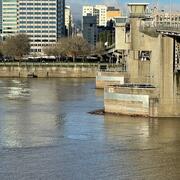I started with USGS as a hydrologic technician in 2006 in the Arizona Water Science Center. I spent my time in Arizona canvasing wells in support of a Colorado River Decree Accounting project where USGS was charged with collecting precise GPS positions and water levels for wells screened in alluvium connected to the lower Colorado River. In 2008, I joined the Idaho Water Science Center as a member of the Boise Field Office to operate surface water gages and manage data collection for a project aimed at characterizing nutrient, sediment, and chlorophyll-a transport in the Boise and Snake Rivers. In 2010, I became a project hydrologist in Idaho Water Science Center and interpreted the data I had collected in the Boise and Snake Rivers. As a project hydrologist, I proposed and managed several projects assessing nutrient loading and habitat quality in the Boise River watershed and kicked off a project in the headwaters of the Salmon River looking at metals loading and transport through a mining district scarred by recent fires. When I moved to California to become a Water-Quality Specialist in 2016, I helped lead the center through NWIS Time-Series database modernization. I served as a member of the USGS Continuous Water-Quality Committee from 2019-22, and continue to collaborate with co-authors on forthcoming updates to techniques and methods for quality assuring time-series water-quality data. I have also had the privilege of sharing USGS methods for time-series water-quality data collection and review on international projects in Iraq and Brazil.
After serving the California Water Science Center as a water-quality specialist for 5 years I was ready for a new challenge where I could pair my expertise on problem-solving and guidance on data collection, review, and interpretation with my passion for supporting, mentoring, and empowering employees to be and do their best. Thus, I jumped at the opportunity to join Oregon Water Science Center in 2021 as the Associate Director for Hydrologic Studies. In addition to offering a new professional challenge, working in Oregon Water Science Center brings me closer to places I have intimately studied and explored earlier in my academic and professional careers. Oregon Water Science Center offers ample opportunity to engage in projects aimed at assessing post-fire watershed response and sediment transport. As a long-time Western resident, I directly appreciate Western water-resources management challenges during times of drought and increased susceptibility to landscape disturbances related to climate change. As ORWSC enters a new era of data-collection and research funded through Water Mission Area appropriated programs, I remain dedicated to a longer-term vision supporting our place-based funding partners such that they can effectively manage the water-resources needs of diverse communities and ecosystems.





